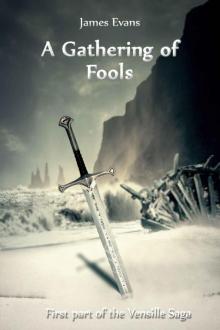- Home
- James Evans
The Royal Marine Space Commandos- RMSC Omnibus Page 2
The Royal Marine Space Commandos- RMSC Omnibus Read online
Page 2
“Sir!” Hughes barked in acknowledgement as he turned and followed the governor.
There was a burst of gunfire from somewhere beyond City Hall. Outside, firing towards the Hall, according to their HUDs. Atticus signalled his troops forward, leading them out onto the open ground and quickly across.
“Campbell take Section 2, inside, sweep the building, head for the front. Section 3, with me, we’ll flank them around the east of the building.”
Atticus watched the Marines of Section 2 heading out, their brand new mil-tech clones in tip-top condition, equipment gleaming, uniforms as yet untainted by the muck of a new world.
Then he headed for the corner of the building and the dusty parkland beyond it. Section 3 followed him as Section 2 triggered the door controls and disappeared into the building. Atticus paused briefly as Section 3 flowed smoothly around the edge of the building, seeking the enemy. He watched their indicators, and those of Section 2, moving steadily across the map in his HUD.
Then he hefted his rifle and followed his troops, Sergeant Jenkins and Marine Butler at his side.
2
Atticus crouched behind a chest high concrete wall atop a squat building that housed what Governor Denmead assured him were dangerous, but not explosive, chemicals. Terraforming required sweeping, long-term changes to the atmosphere and soil of a planet. In the short term, what the colonists needed was massive hydroponic systems packed with the best nutrients chemistry could refine.
There were dozens of buildings like this across the city, all storing different resources that had been shipped in by unmanned supply craft before colonists arrived or else were being manufactured locally by the automated extraction plants the colonists had installed.
Powered armour and surveillance drones had changed the face of the battlefield but having a high vantage point from which to observe the enemy was still helpful. Atticus especially liked having two feet of brutally ugly concrete wall between him and the enemy. The building might be austerely functional, but the colonists had covered the roof with green matting, sunbeds and chairs. Not that there was much weather to enjoy, he supposed, but it was no worse than the average British seaside town.
He turned back to face Governor Denmead, wishing she hadn’t joined him but impressed that she was putting herself on the front line.
“What can you tell me, Governor? Anything about their weapons and equipment?”
“Some of them have powered armour but not all of them,” she said.
Atticus took that news with aplomb. "You’re certain?”
“Captain Atticus, I shot one in the face earlier today, and it barely fazed him. And I’m not the only one who’s seen them in suits,” she admonished him.
“Fair enough. It’s unusual for brigands to have powered armour, but I’m sure we can take care of it,” he replied.
“They have military clones as well,” she went on as Atticus raised an eyebrow. Obtaining military-grade clones was not only utterly illegal for non-government bodies but also extremely difficult. The modifications built into such clones were strictly for combat use and even the Sol governments rarely deployed troops in such clones. Outside of a troop deployment ship, military-grade cloning bays were almost unheard of.
“What kind of modifications have you seen? Could they be fringe planet black market clones?” he said, suggesting these were inexpert hacks that the brigands might have jury-rigged onto civilian clones.
“Captain,” said Denmead in a tone pitched to close the argument, “I’ve been around long enough to recognise a back-alley clone. This force has full-size wings for their scouts. Eight-foot-tall, heavy weapons grunts and reports of some kind of close combat trooper that was fully mutated with natural armour, bladed arms and fangs. They are definitely high-quality military clones,” she insisted.
“Fangs?” asked Atticus sceptically.
Denmead shrugged. “That report might be a bit far-fetched,” she admitted.
“Any idea where they’re operating from?”
Denmead pulled a data slate from her jacket and projected an image on the concrete wall, a map of the central colonised areas of New Bristol.
“No, not yet,” she said, tapping the slate and pinging a series of locations within thirty kilometres of Ashton, “I haven’t had much time, but these are the places I think are most likely. I’ve made a lot of assumptions, of course, and I’m not a military expert. Everyone in the outlying settlements is dead or here with us in Ashton, in fact. They could be using any of the outlying sites.”
“How long have they been here?”
“We don’t know,” Denmead said, flinching as a burst of fire echoed from a nearby street, “they attacked the most distant locations first. Atmospheric processors, automated mineral extractors, energy farms. Most elements of our terraforming infrastructure are distributed in small pockets in case of unexpected atmospheric conditions or accidents. Only larger sites that require regular attention have a team that live onsite; any others are visited on rotation. They’d probably been attacking us for days before anyone managed to survive long enough to raise the alarm.”
“Do you have any working fab units capable of making small arms?”
“Yes, but nothing large scale,” Denmead said.
“We’ll take whatever you can produce. I’ll authorise you to set them making military weapons,” Atticus said. Through his HUD he sent a clearance code to the governor that would unlock the restricted military patterns held by the colony’s fabricators, along with a priority list of items to manufacture.
“Thank you, Captain. Our weapons aren’t much use against these clones or their powered armour.”
“Can you show me where your teams are?”
Denmead tapped her slate again, and the projection on the wall showed a series of blue, green and red dots. Blue for citizens who had joined the improvised militia and green for non-combatants, who were mostly hiding in buildings back from the front line.
Great areas of red hatching showed ground already lost or where the enemy troops were known to be. She sent a data stream to Atticus and he reviewed it on his HUD. It was basic information, but the tactical overlay could absorb the feed and update the Marines’ maps once the drones started providing more accurate data.
With the data came the colonists’ health statuses, streamed from their personal monitoring bracelets. It was less comprehensive than the information Atticus had on his Marines but just knowing where people were and whether they were injured or dead was invaluable.
“It’s time to pull your people back, Governor. We’ll take over and we don’t want your people getting caught in the crossfire,” Atticus.
“I understand. Where do you want our line? My people have children to protect.”
“Here, here and there, are good.” Atticus pointed at a few buildings that would give good sight lines around the colony and allow the militia to act as a rearguard for his teams.
“Very well, I’ll issue the order to fall back and then I’ll retreat to our administrative backup here,” Denmead said, indicating a reserve building which also held a cluster of green dots. “It’s nothing special but it’s got reserve power and access to most systems in case of a major problem with city hall.”
“Roger that, Governor. Best of British to you,” Atticus said as she made her way back down from the roof.
3
“Coming up on EDB two in one hundred metres, sir,” said Corporal Goodwin.
“A lot of smoke here. Something’s wrong. Fan out, keep to cover. Goodwin, get a drone up,” ordered Lieutenant Warden. It wasn’t necessary to order his Marines to take cover, they all had more experience than he did, but it needed to be a habit. Someday, he would have brand new marines to look after and they would need his guidance.
Goodwin had already thrown a micro-drone, shaped like a giant dart, in as high an arc as she could. It unfurled and stabilised as its rotors activated. An icon appeared in Warden’s heads-up display to indicate there was a
recon drone actively broadcasting video.
“Got anything, Goodwin?” asked Sergeant Milton, not taking her eye from the sight of her carbine as she scanned the buildings ahead.
“Not yet, Sarge. Want me to have a shufty?” Goodwin asked.
“Get your bird out there, Goodwin. I want to know where that smoke is coming from before we get there,” Warden said.
The tiny drone, not much larger than the hummingbird it imitated, darted forward scanning the combat zone ahead. Goodwin would be concentrating on the video feed, the infra-red and sonar information that the drone provided. Milton was tailing her close, much like a spotter looking after her sniper. If anything happened, Milton would have Goodwin down and in cover even if she was distracted by the wealth of data she was monitoring.
They’d made two advances, one group dashing to the next available cover while another covered them, then sprinted to safety themselves, before Goodwin received an update.
The icon blinked in Warden’s view and Goodwin’s message scrolled across his HUD.
Warden swore under his breath. He ducked behind a concrete waste bin as the drone’s feed expanded into his HUD.
The cloning bay, technically an RMSC Emergency Deployment Bay, was a squat concrete building with a staircase running up the outside and a high-bandwidth comms array on the roof. Or at least, it had been. Now, it was little more than rubble. The bay, effectively a bunker, had lost its north wall and its roof had collapsed.
Normally the bays were buried, hidden from hostile eyes beneath tons of soil or concrete, but build details were determined by the colonists and the local conditions. Colonies had considerable operating leeway and could make their own decisions about building deployments. It was part of the attraction of life on a frontier world.
In Ashton, the second bay had been built in the open. The bay that Atticus and A Troop had decanted into was underground in the basement of a solar plant control room, much better protected.
Goodwin sent the drone through the hole in the north wall, checking the damage. The message
They had targeted the cloning facility, presumably to destroy it and cripple the RMSC’s response capability. That suggested a level of tactical thinking that was unusual in a bandit attack. Whoever the enemy was, they were far too aggressive, too well equipped and too skilled to be treated lightly.
He sent a direct query back to Goodwin,
The enemy was likely still nearby.
The drone darted straight up, and Warden flinched at the sudden shift. Techs did this all the time, but he found it disorienting. There’s a reason I didn’t go into an Intel Group, he admitted to himself.
With a wide view of the area, Goodwin was able to switch to a search mode, focusing on movement, heat profiles, radiation, comms traffic and any other sign of the enemy’s location.
A sea of data and strange imagery swam in front of Warden’s eyes for a few seconds before the chaotic colours and dozens of icons went back to the live feed again. This time, a building to the east of the bay was highlighted, a tall, thin structure, five storeys high, with large panes of glass held in place by a web of foamcrete. Cheap, lightweight and easily constructed, it was unquestionably office space.
All heads in the section swivelled towards it, and the Marines began to reposition themselves without his having to give an order.
Goodwin and Milton caught up with him, using the building on the corner of the crossroads as cover until they could join Warden behind his waste bin on the pavement. “Numbers?” he asked quietly. The lance-corporal shook her head; she didn’t know.
He pondered their options. This felt like a raiding group. They could hear gunfire in the distance, but these troops were here to target valuable assets. If they were a military force from another colonial government, they’d be highly trained specialists, just like his Marines. He was confident of his team's abilities, but nobody was immune to a sniper round, and they didn’t have any heavy weaponry, let alone powered armour. It wasn’t part of the emergency deployment package for a colony this size.
B Troop wasn’t going to be joining them anytime soon. It would take days to grow more clones, even if they could hold the remaining bay. The civilian bay would be a poor alternative, producing less advanced bodies in smaller numbers.
If he charged in without more information, he could very well lose all his Marines. On the other hand, if they sent the drone in, they might reveal themselves to an otherwise oblivious enemy and lose the advantage of surprise.
What was the enemy’s plan? The team that had taken down the bunker had been quick, discreet and efficient. Warden’s Section was probably being watched, but they hadn’t been engaged, so maybe the enemy had targets and orders to avoid conflict. If that were the case, they’d be going for something else of high value, probably the remaining cloning bay or a power facility. Every building contributed to the energy grid but taking out a sizeable generation plant would impact their production of clones and equipment.
Warden shook his head. The decision was easy.
“Goodwin, get me a view inside. I want numbers, locations and armament.” He signalled everyone else to be ready to lay down heavy fire. It wouldn’t be subtle, but if Goodwin could get locations, they could tear through that building even with their basic carbines.
The drone dived, swooping towards a balcony on the top floor. It settled on a narrow upper pane and began to cut through the glass with its laser. It was inside the building in seconds, flitting through the offices and confirming the floor was empty in under a minute. It did an abrupt flip that made Warden’s stomach lurch and rolled to the atrium that plunged through the building.
Righting itself, it zipped into the offices on the fourth floor, angling for the corner that faced Warden’s position. Six figures lit up ahead, and their locations popped on the HUDs of the Marines. Warden saw a glimpse of powered armour before one of the figures turned and raised a small hand weapon. There was a flash, and the feed went black. His HUD automatically went back to the default view; the drone’s icon gained a red cross to show it was disabled.
“Son of a bitch!” Goodwin cried out. “Lieutenant, permission to engage?”
“Granted, Lance-Corporal,” he said, turning to face the building in a crouch and bringing his carbine to bear. The icons on his HUD showed the last known location of each enemy.
Goodwin answered the destruction of her equipment with a two-pronged approach. First, the defunct drone detonated with an almighty noise and a light bright enough to blind. Secondly, she brought her carbine to bear and with a triple popping noise and a panning motion, expertly fired three grenades through windows on the fourth, third and second floors, one above the other.
The detonations were nigh on simultaneous, a staccato cacophony that could be felt as a bass rumble in their chest. It was accompanied by bursts of fire from the entire section. Goodwin had already thrown another drone and Warden could hear her cursing the enemy under her breath and vowing revenge.
It came quickly. As the clouds of dust billowed out and the drone's data reached their HUDs, the Marines could see the softly glowing outlines of four figures on the ground floor. Two more were outlined in blue, lying prone in the rubble.
As soon as the drone pinged the enemy powered armour units, Warden’s section opened fire. Each marine fi
red bursts with expert precision into the dust cloud, guided by the drone’s sensors. They were rewarded with the distinctive metallic pings of bullets striking powered armour.
“Grenades!” ordered Warden and a flurry of ordnance arced across the open space, detonating directly on or near the blue outlines as the drone skipped back to avoid the blasts.
The final grenade detonated at the roof of the building, still hanging precariously above the vacant space below it. It collapsed with a resounding crash, directly on top of the enemy position. Warden glanced to his left and saw a smug grin on Milton’s face. He nodded in approval and turned to Goodwin.
“Survivors?” he asked.
She jabbed at her drone interface a few times and shook her head. “Can’t say for certain, sir, but no signs of life.”
“Take a breather, folks. Let’s see if any of those bastards get up,” Warden cast over the comms.
“No movement, no energy signatures, sir,” Goodwin announced a minute later.
“Let’s move in then,” Warden said as he ordered the advance via the section’s HUDs.
They moved across the open ground, weapons trained on the pile of rubble that was all that remained of the corner of the building. The explosions had strewn debris all over the street, leaving everything within fifty metres of the shattered structure covered in dust and grime.
Goodwin’s drone shot straight up, climbing to two hundred metres before it began to follow a spiral holding pattern, scanning a much broader area for signs of life, enemy or ally.
Warden pulled a pocket open on the neck of his jacket and slid an air filter up from it to cover his mouth and nose. It wasn’t capable of protecting him from an active weapons attack, but it was ideal for sandstorms or billowing clouds of concrete dust and particulates. Most of the section followed suit; their HUDs already protected their eyes.

 The Royal Marine Space Commandos- RMSC Omnibus
The Royal Marine Space Commandos- RMSC Omnibus Guerrilla
Guerrilla Commando
Commando Gunboat
Gunboat A Gathering of Fools (Vensille Saga Book 1)
A Gathering of Fools (Vensille Saga Book 1) A Gathering of Fools
A Gathering of Fools Zombie Destruction: Love in the Age of Zombies Book Three
Zombie Destruction: Love in the Age of Zombies Book Three